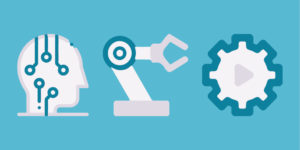Artificial Intelligence, Robotics, and the Future of Tax Automation

Chances are good that you’ve heard about how Artificial Intelligence (AI) and robotics (or “bots”) will be changing the way we live in the coming years. You may have even heard that AI and robotics will impact the tax world, including sales and use tax.
While it’s early to predict exactly what kind of impact these things will have on sales tax and on tax professionals everywhere, it seems fairly safe to say that they will have an effect. You can expect AI and robotics to change the way that you or your co-workers operate on a daily basis.
Now is a good time to get a feel for how AI and robotics could impact you. It may be coming sooner than you think and being prepared is the first step in ensuring that you make the transition smoothly.
The discussion about AI, bots and sales tax revolves largely around the issue of tax automation. It seems clear that AI and bots can help automate the tax function with fewer errors and fewer hours. This could likely free up people to focus on more value-added functions. It would be helpful to first look at the history of tax automation, so we can see how we’ve gotten to this point.
I was able to dig into this topic as I spoke on it at the COST Annual Conference this month. We haven’t done much development in this area, but it is something we want to understand so we can help you evaluate how it can help you.
A Brief History of Tax Automation
Sales tax automation has been around in some form since the mid-1970s. The two original tax automation pioneers – Taxware and Vertex – created a “sales tax rate file.” In 1989, the first sales tax calculation product was launched. In the mid-1990s, we began to see more robust sales tax automated products hit the market.
Modern, web-based solutions emerged in the 2000s. Along the way, some tax professionals came up with custom solutions. For example, building macros in Microsoft Excel was similar to an “early days” version of using bots to automate the sales tax function.
How Can AI and Bots Help in Administering Sales Tax?
Today, some companies already have bots and AI assisting in performing a variety of tax functions. So what are some of the areas where bots and AI (and tax automation in general) can assisting with administering the tax function? Here are just a few:
- Compliance
- Nexus Information Gathering
- Taxability Mapping
- Reserves
- Audit Documentation Gathering
- Exemption Management
- Reverse Audits
Why are AI and bots such a good fit for transaction tax automation? Well, collecting and analyzing the data to administer the sales tax function today means dealing with huge amounts of data. This is something that may be better left to bots, which can do the work more quickly and efficiently than humans. Not to mention, bots can do it with far less error.
How Can We Incorporate AI and Bots into Our Tax Function?
Sounds good, right? So your next question might be: How do I go about incorporating AI and bots into our company’s tax function? Well, incorporating tax automation of any kind into your business is rarely pain-free, but it may not be as bad as you imagine. Here is a 5-point plan to get you thinking about how you can tackle the process:
- Determine the “pain points” in your sales and use tax function. What items are employees spending significant time on? Where are errors frequently being made? These are exactly the areas where AI and bots can be most useful.
- Assess how much time and resources are currently being used in items such as sales and use tax data collection.
- Automate data manipulation – consider a tax engine implementation or use tax calculations to reduce errors and the time spent on this function.
- Work with the other departments in your company (especially IT) to develop a roadmap for automation and incorporating AI and bots.
- Work with management and other departments in your company to evaluate vendor solutions.
Once you go identify a few processes with pain points, pick something small to start. In talking to others that have developed solutions, take an agile approach – start small and easy and get through a proof of concept and then gradually add more functionality and complexity.
Something you will want to include in your plan is the ability to measure its value. This could be speed of the process or number of hours or accuracy. If you currently outsource or offshore the function you are looking to automate, it is likely your provider has metrics on every process. Talk to them to find out what you are looking to solve.
These new technologies are likely something your IT department has been looking at already. Talk to your IT leadership or if you have a tax technologist as part of your team, work with them. AI and Bots are the new “shiny” toy that IT likes to find a function to experiment with to see how it can work. You might not even have to go outside your company for technical resources. Also, don’t forget to get your executive leaders involved and get their support. One thing you should try to accomplish is a pilot or proof of concept at a low cost. If you can show a small success, they are likely to support a larger project.
Another suggestion from those that have gone through the process is to establish a governance process. Determine a nomination process as well as the evaluation process. Make the nominator detail the pain points, the current process and the benefits of converting the process to an automated process. The value or benefits might be quantitative, but they might also be qualitative. Make sure to ask for both on the nomination form.
What Challenges or Objections Might Occur?
In talking to some people that have implemented robotics and AI, their biggest challenge revolved around security. If you have a bot that needs to log into systems, you need to figure out how the bot can act like a person – particularly if you have two factor authentication. Can a bot generate a code on a phone to enter? It can – with a little creativity. One company actually has to assign the bot to a manager for HR purposes – he’s hoping there isn’t an annual review process that gets caught in a crazy loop!
Another concern that I often hear is that this is just a way to reduce headcount. Of course, that is always possible but companies that are really embracing AI and robotics sees it as a way to bring outsourced functions back in house at significantly lower cost and higher quality in a way that allows the human staff to focus on more fulfilling and higher value-added tasks. This might require the company to re-skill people. And of course, not everyone will be willing to learn new tasks and embrace the new technology. These people might not adapt and therefore they might not have a role in the new environment. But many companies are doing all they can to not have this happen. It is important to involve the impacted staff in the project and to communicate early, often and openly. This will allow them to get excited about the opportunity and reduce their stress and anxiety.
So How Will This Change the Tax Landscape?
There are major benefits to incorporating tax automation, AI and bots into your company’s tax function. As mentioned above, you can expect to see fewer errors and less employee time spent on routine data collection and manipulation. Fewer errors can lead to reduced audit risk, less threat of consumer lawsuits, and cost savings across the company.
This frees you and your co-workers to focus on higher-level, more strategic projects. Which leads me to my final point on AI and robotics. While there are undoubtedly many potential benefits to using AI and bots in the tax function, it also raises a scary question. Can AI and bots make your job irrelevant? Maybe – but only if you aren’t willing to adapt.
In light of how AI and bots may have a sweeping impact on the world of sales and use tax, I encourage tax professionals to get ahead of the curve and develop additional job skills within your specialty.
If your job consists of a lot of routine data gathering and manipulation, you should consider what other skills you can bring to the table, such as tax research, higher level data analysis and strategizing. Because it is very likely that many routine data tasks will eventually be outsourced to bots.
Looking to learn more about AI, Robotics and the Tax Function?
Check out the following articles for additional information:
- The Robots Are Not Just Coming, They Are Already Here
- Your Tax Data Is Ripe for Artificial Intelligence. Are You Prepared?
- Five Ways Artificial Intelligence is Changing Tax
- Artificial Intelligence – Entering the World of Tax
- Tax Value of Robotic Process Automation
If your company has evaluated and even implemented some AI, Robotics or other advanced automation I would love to hear about it. Drop me a line if you would like to share your creativity and any additional guidance to those that might be just starting out.
 About the Author:
About the Author: